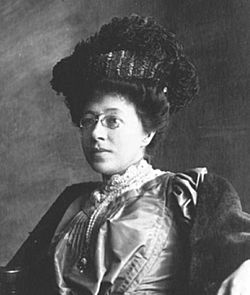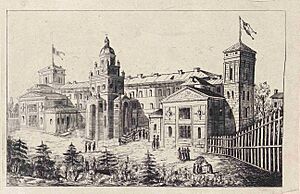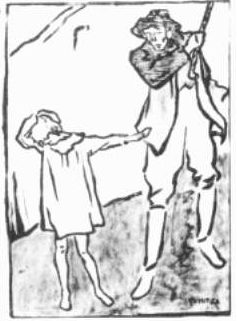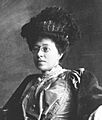Mărgărita Miller-Verghy facts for kids
Quick facts for kids
Mărgărita (Margareta) Miller-Verghy
|
|
|---|---|

Miller-Verghy, studio photograph
|
|
| Born | January 1, 1865 Iași, United Principalities (now Romania) |
| Died | December 31, 1953 (aged 88) Bucharest, Romania |
| Pen name | Ariel, Dionis, Ilie Cambrea, Ion Pravilă, Mama Lola, Marg. M-V., Marmill |
| Occupation | Journalist, critic, translator, schoolteacher, philanthropist, nurse, inventor |
| Period | 1883–1953 |
| Genre | Children's literature, detective fiction, memoir, novella, radio drama, travel writing |
| Literary movement | Neoromanticism, Sămănătorul, Viața Românească |
| Signature | |
Mărgărita Miller-Verghy (born January 1, 1865 – died December 31, 1953) was a famous Romanian writer and important person in society. She was also a schoolteacher, journalist, and translator. Mărgărita helped create cultural groups and was involved in starting women's organizations.
Her most important contributions to Romanian literature include translating books from English and writing about women authors in Romania. She also wrote a series of short novels and a very popular detective story. Many of her other works taught lessons and were meant to educate.
Even though an accident made her completely blind, Miller-Verghy kept writing and working for women's rights in the 1920s and 1930s. She helped set up charity groups and was a pioneer in Romanian Scouting. Around 1940, she was also known for her work in radio drama, which are plays made for radio.
Mărgărita Miller-Verghy was friends with many famous cultural figures of her time. These included well-known writers like Barbu Ștefănescu Delavrancea and Mateiu Caragiale, as well as the musician Cella Delavrancea.
Contents
Biography
Early Life and Education
Mărgărita Miller-Verghy was born in the city of Iași, Romania. Her family had roots in both Poland and Romania. Her mother, Elena Verghy, came from a noble family in the Moldavia region. Her father, Gheorghe Miller, was a teacher and also a politician in the Senate of Romania.
When Mărgărita was young, her father died suddenly in 1869. Her mother took Mărgărita and her sister to Switzerland. Mărgărita was a smart but often sick child. She spent about eight years abroad, where she learned six languages and studied many classical subjects.
In the 1870s, her family moved to Bucharest. Mărgărita's mother ran a girls' school. This school was the first in Romania to offer Baccalaureate exams for women. Mărgărita attended her mother's school and finished her Baccalaureate at Elena Doamna High School in 1877.
Mărgărita's older sister, Elena, married a judge named Alexandru Lupașcu. The Miller-Verghy women became like a family to Barbu Ștefănescu Delavrancea, a new writer who later became famous. Mărgărita was especially close to him and they wrote letters to each other.
All three women often went to literary events and met famous people like V. A. Urechia. In the 1880s, Mărgărita also met Mihai Eminescu, who is now known as Romania's national poet.
Starting Her Writing Career
Mărgărita began her own writing career in 1883. One of her short novels was published in the Națiunea newspaper under the name Marmill. In 1892, she tried translating some of Eminescu's poems into French. She might have been the first person to publish such translations.
Her translated book, Quelques poésies de Michaïl Eminesco ("Some of Mihai Eminescu's Poems"), was published in Geneva in 1901. The poet Alexandru Vlahuță wrote the introduction for it. The Familia magazine called it a "remarkable" work.
Miller-Verghy continued her studies at the University of Geneva. She earned a degree in Letters and a Doctorate in Philosophy between 1894 and 1895. After returning to Romania, she became a teacher at girls' schools in Bucharest. She also became the headmistress of Elena Doamna High School.
In 1900, she published her own book to help teach French. In 1903, she translated Alexandru Vlahuță's Picturesque Romania into French. She wrote a regular column in the Bucharest newspaper La Patrie using the name Ariel. She also wrote articles for the literary magazine Sămănătorul as Dionis. Miller-Verghy also became a vice president of the Maison d'Art club, a charity group led by Princess Elisabeth of Romania.
She helped organize the vocational education department at Elena Doamna High School. She even showed their work at the Romanian Atheneum in 1907. She then published a booklet about arts and crafts in 1908. She was so interested in this that she even patented her own teaching tool for girls, a loom she called Statu-Palmă.
Miller-Verghy continued to translate famous works. She worked with Adela Xenopol on a play that included Eminescu's poems in 1909. She also translated William Shakespeare's King Lear for the National Theater Bucharest. The National Theater also asked her to translate Macbeth and As You Like It, as well as Robert Browning's Blot in the 'Scutcheon.
As an art critic, Miller-Verghy studied the history of weaving patterns and symbols. She believed they had very old, pre-Christian origins. She wrote about the swastika as both a good and bad symbol. She also thought that the ancient Thracians, ancestors of Romanians, might have created the Trojan and Etruscan civilizations. Her research led to books like Izvoade strămoșești ("Ancient Sources") and Motifs anciens de décorations roumaines ("Ancient Romanian Patterns and Decorations"), both published in 1911. That same year, she represented Romania at the first World Congress on the study of children.
Miller-Verghy also wrote short stories and memoirs, often for children's literature. She used names like Marg. M-V., Mama Lola, and Ion Pravilă. Her children's books were well-received. In 1912, her book for teenagers, Copiii lui Răzvan ("Răzvan's Children"), won an award from the Romanian Academy.
Throughout her life, Miller-Verghy wrote for many newspapers and magazines, including Viața Românească and Flacăra. She was also active in society, serving on leadership committees for several groups. She wrote more textbooks too. In 1912, she translated a work by Elizabeth Barrett Browning. She was also a founding member of the Româncele Cercetașe Association, an early part of Romanian Scouting, created in 1915.
World War I and Later Years
By 1914, Miller-Verghy became the official translator for Romania's English-speaking Crown Princess, who later became Queen Marie of Romania. They worked together on stories like Visătorul de vise ("Dreamer of Dreams") and Ilderim, Poveste în umbră și lumină ("Ilderim: A Tale of Light and Shade"). Miller-Verghy also translated Queen Marie's story "Four Seasons from a Man's Life" in 1915. Queen Marie was also very impressed by Miller-Verghy's translation of Rabindranath Tagore's Gardener.
From 1914 to 1916, before Romania joined the Allied Powers in World War I, Miller-Verghy ran a cultural club in Bucharest. This club was known for supporting Germany and the Central Powers. Famous people like pianist Cella Delavrancea and poet Mateiu Caragiale attended this club.
In 1916, Romania joined the Allied Powers. After some initial success, the country was invaded by the Central Powers. During the Battle of Bucharest, the Elena Doamna School became a crowded military hospital. Miller-Verghy became a registered Romanian Red Cross nurse. In June 1918, during the occupation of Bucharest, she helped create a charity group for war orphans. This group continued to help children even after the war ended.
Mărgărita Miller-Verghy continued her cultural work after the war. She wrote a travel guide called La Roumanie en images ("Romania in Pictures", Paris, 1919). This book was for French and international readers, hoping to teach them about Greater Romania. She also finished a novel called Theano, named after a character from Greek mythology, and a play called Pentru tine ("For You").
On May 19, 1922, Mărgărita Miller-Verghy became a member of the Romanian Writers' Society (SSR). This was the first professional group for writers in Romania. At that time, she managed a small theater in Bucharest. This theater was known for hosting experimental plays and a theater festival attended by Queen Marie. She also returned to writing for children. She even wrote a plan for a screenplay and silent film called Fantomele trecutului ("Ghosts of the Past").
Later Life and Achievements
Before and during World War II, Miller-Verghy mostly wrote plays. Her plays Garden-party (1938) and După bal ("After the Ball", 1939) were performed in Bucharest. Radio Bucharest broadcast her audio plays Derbyul ("The Derby") and Ramuncio. The Academy gave her an award in 1944 for her novel Cealaltă lumină ("That Other Light").
In 1946, even though she was blind and getting older, Miller-Verghy published her most famous fiction book, Prințesa în crinolină ("The Princess in Crinoline"). This book was a big success in popular fiction and was a breakthrough in the Romanian detective novel genre. It was a "sensational mystery" that influenced a new generation of women writers. The story follows amateur detectives Diomed and Florin, who, with their female friend Clelia, solve the murder of Princess Ralü Muzuridi. The plot takes them to famous churches and cities, high society parties, and they even meet a fictional version of a journalist.
The war made Miller-Verghy poor, and she relied on help from her former students. She still worked as a translator. She translated Ursula Parrott's Strangers May Kiss and George Meredith's Rhoda Fleming. During the early years of the communist government, she wrote her last plays: Gura lumii ("People Talk") and Afin și Dafin ("Bilberry and Laurel").
Mărgărita Miller-Verghy died at her home in Bucharest on December 31, 1953, just before New Year's Day. She was buried next to her mother Elena, at Bucharest's Bellu cemetery.
Images for kids




